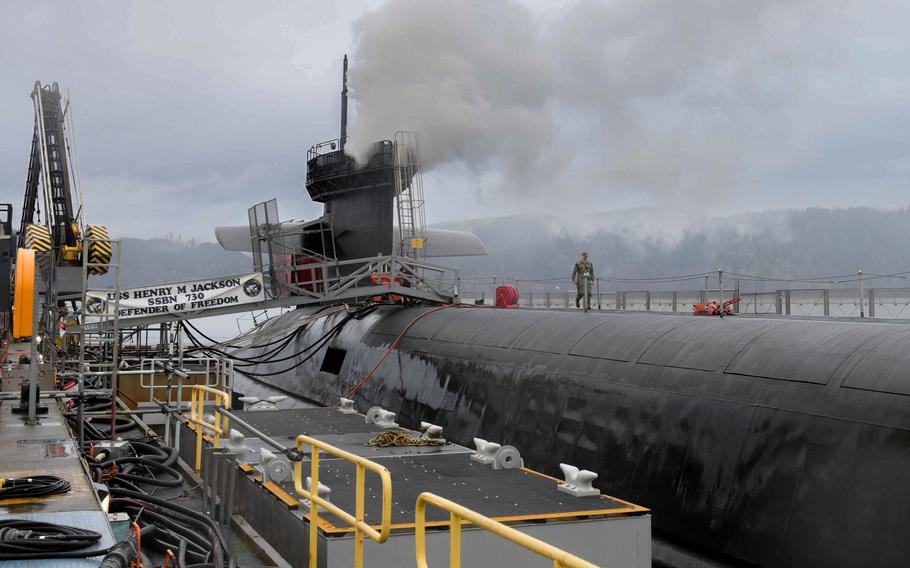
Ohio-class ballistic missile submarine USS Henry M. Jackson docked at Naval Base Kitsap, Wash., Dec. 28, 2023. (Adora Okafor/Navy)
WASHINGTON — The Pentagon has identified six areas of focus necessary to implement its first-ever industrial defense strategy meant to strengthen shipbuilding efforts and weapons production to keep pace with military competitors such as China.
The Defense Department released in January its National Defense Industrial Strategy — a “call to action” to build a modernized 21st century defense sector. But at the time, there was no plan of how to approach it. The Pentagon announced Tuesday that defense officials now have mapped out a method for implementing that strategy.
“In January, I sat here and stated we can no longer afford to wait. The time for action has come. I believe we have confronted that task and are moving ahead,” Laura Taylor-Kale, assistant secretary of defense for industrial base policy, said Tuesday during a media roundtable at the Pentagon.
Updating Army depot facilities, ramping up munitions production, and increased collaboration with allied partners and industry leaders are among the initiatives outlined by the National Defense Industrial Strategy plan.
The six initiatives require senior leaders to focus on deterrence in the Indo-Pacific region, production and supply chains, industrial collaboration with allied partners, modernization of capabilities and infrastructure, the pursuit of new capabilities via flexible paths, and intellectual property and data analysis. The plan will be funded by an estimated $38 billion outlined in the proposed White House budget for fiscal 2025.
Focusing on Indo-Pacific deterrence includes producing more munitions and missiles and strengthening the submarine industrial base, which the report described as “top requirements” for the U.S. to counter threats in the region.
The Navy announced in April that four shipbuilding programs are one to three years behind schedule, projecting the first Columbia-class submarine to be between 12 and 16 months late and the more-modernized versions of the Virginia-class submarines to be 36 and 24 months late.
In September, lawmakers were notified by the Navy of a near $2 billion budgeting shortfall for two Virginia-class submarines that threatens to further delay construction.
The industrial strategy outlined in the plan seeks to remediate such problems plaguing the submarine industrial base. The plan would follow a five-year timeframe, estimating the Navy will produce one Columbia-class and two Virginia-class submarines per year by 2029.
The focus on the Indo-Pacific also seeks to modernize Army depots and increase production of U.S. arsenals. The Defense Department is prioritizing the production of precision-guided munitions as well as longer range missiles necessary for potential conflict in the region. The weapon systems includes land-attack missiles, such as precision-strike missiles, joint air-to-surface standoff missiles, and Tomahawk land-attack missile upgrades, and the new long-range, anti-ship missiles designed for naval warfare.
“U.S. material support to Ukraine has revealed challenges in maintaining, reconstituting, and increasing production of U.S. munitions stockpiles. Failure to maintain, and potentially increase, these stockpiles risk operational capability and force readiness,” the report reads.
Inaction in these areas could mean the U.S. could not keep up with the growing Chinese military or compete globally.
Collaborating with others is another focus of the plan, which emphasizes the need to work together with allied partners and industry leaders to strengthen the industrial defense base, and share and field new capabilities. This includes the trilateral pact between Australia, the United Kingdom and the U.S. — or AUKUS — which is meant to challenge China’s armed forces and protect the open waters in the Indian and Pacific oceans.
In the past three weeks, the three countries have been testing the ability to co-operate maritime drone systems and share and process data to accelerate emerging weapons such as autonomous drones.
The Pentagon is also looking to modernize weapons and infrastructure through the nuclear and organic industrial bases, and maintenance, repair and overhaul capacity.
This includes the Army embarking on a 15-year plan to update its depots. These government facilities ensure weapons and equipment built by the commercial defense industry stay operational for decades.
The development of the defense industrial strategy and its implementation plans have been in the works since 2018.
This is the first iteration of the plan, which Carla Zeppieri, deputy assistant secretary of defense for industrial base resilience, said is like a living document.
“This is also the first time the department has had an industrial strategy and now an implementation plan to actually make this real — not that prior efforts weren’t sincere,” she said. “We now have the entire department, and I think, a lot of momentum and buy into this process.”
The implementation plan will be updated each year as needed, Zeppieri said.